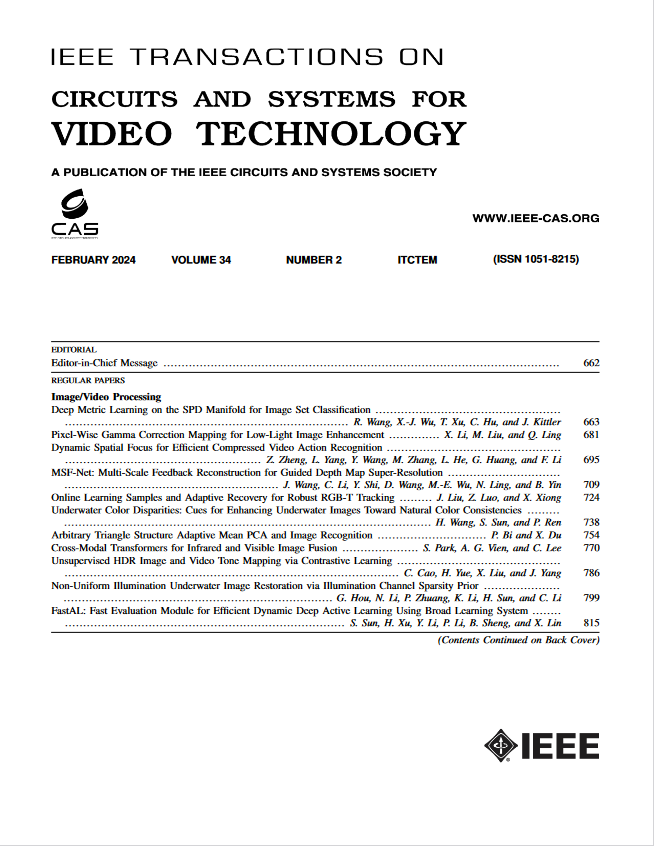DiffVein:用于指静脉分割和身份验证的统一扩散网络
IF 8.3
1区 工程技术
Q1 ENGINEERING, ELECTRICAL & ELECTRONIC
IEEE Transactions on Circuits and Systems for Video Technology
Pub Date : 2024-08-09
DOI:10.1109/TCSVT.2024.3404865
引用次数: 0
摘要
手指静脉身份验证以其高度的安全性和特异性成为生物识别领域的研究热点。传统方法主要集中在静脉特征提取上进行判别建模,对生成方法的探索有限。现有方法存在验证失败的问题,无法通过分割得到真实的静脉形态。为了填补这一空白,我们引入了DiffVein,这是一个统一的基于扩散模型的框架,同时解决了静脉分割和认证任务。DiffVein由两个专用分支组成:一个用于分割,另一个用于去噪。为了更好地在这两个分支之间进行特性交互,我们引入了两个专门的模块来提高它们的整体性能。第一个是掩模条件模块,它将来自分割分支的静脉模式的语义信息整合到去噪过程中。此外,我们还提出了一种语义差分转换器(SD-Former),它使用傅里叶空间自注意和交叉注意模块提取类别嵌入,然后将其提供给分割任务。通过这种方式,我们的框架允许扩散和分割嵌入之间的动态相互作用,因此静脉分割和认证任务可以在联合训练中相互通知和增强。为了进一步优化我们的模型,我们引入了一个傅立叶空间结构相似度(FSSIM)损失函数,该函数是为提高去噪网络的学习效率而定制的。在USM和THU-MVFV3V数据集上进行的大量实验证实了DiffVein的卓越性能,为静脉分割和认证任务设定了新的基准。本文章由计算机程序翻译,如有差异,请以英文原文为准。
DiffVein: A Unified Diffusion Network for Finger Vein Segmentation and Authentication
Finger vein authentication, recognized for its high security and specificity, has become a focal point in biometric research. Traditional methods predominantly concentrate on vein feature extraction for discriminative modeling, with a limited exploration of generative approaches. Suffering from verification failure, existing methods often fail to obtain authentic vein patterns by segmentation. To fill this gap, we introduce DiffVein, a unified diffusion model-based framework which simultaneously addresses vein segmentation and authentication tasks. DiffVein is composed of two dedicated branches: one for segmentation and the other for denoising. For better feature interaction between these two branches, we introduce two specialized modules to improve their collective performance. The first, a mask condition module, incorporates the semantic information of vein patterns from the segmentation branch into the denoising process. Additionally, we also propose a Semantic Difference Transformer (SD-Former), which employs Fourier-space self-attention and cross-attention modules to extract category embedding before feeding it to the segmentation task. In this way, our framework allows for a dynamic interplay between diffusion and segmentation embeddings, thus vein segmentation and authentication tasks can inform and enhance each other in the joint training. To further optimize our model, we introduce a Fourier-space Structural Similarity (FSSIM) loss function, which is tailored to improve the denoising network’s learning efficacy. Extensive experiments on the USM and THU-MVFV3V datasets substantiates DiffVein’s superior performance, setting new benchmarks in both vein segmentation and authentication tasks.
求助全文
通过发布文献求助,成功后即可免费获取论文全文。
去求助
来源期刊
CiteScore
13.80
自引率
27.40%
发文量
660
审稿时长
5 months
期刊介绍:
The IEEE Transactions on Circuits and Systems for Video Technology (TCSVT) is dedicated to covering all aspects of video technologies from a circuits and systems perspective. We encourage submissions of general, theoretical, and application-oriented papers related to image and video acquisition, representation, presentation, and display. Additionally, we welcome contributions in areas such as processing, filtering, and transforms; analysis and synthesis; learning and understanding; compression, transmission, communication, and networking; as well as storage, retrieval, indexing, and search. Furthermore, papers focusing on hardware and software design and implementation are highly valued. Join us in advancing the field of video technology through innovative research and insights.

 求助内容:
求助内容: 应助结果提醒方式:
应助结果提醒方式:


